Petronas Towers
The Petronas Towers, also known as the Petronas Twin Towers (Malay: Menara Petronas, or Menara Berkembar Petronas), are twin skyscrapers in Kuala Lumpur, Malaysia. According to the Council on Tall Buildings and Urban Habitat (CTBUH)'s official definition and ranking, they were the tallest buildings in the world from 1998 to 2004, until they were surpassed by Taipei 101. The Petronas Towers remain the tallest twin towers in the world.
| Petronas Towers | |
|---|---|
Menara Berkembar Petronas | |
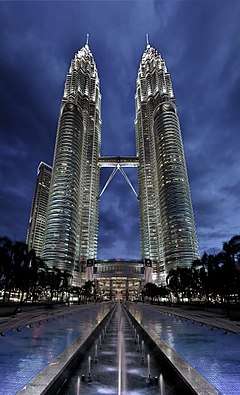 | |
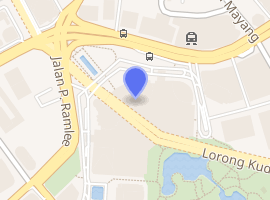
| |
| Record height | |
| Tallest in the world from 1998 to 2004[I] | |
| Preceded by | Willis Tower |
| Surpassed by | Taipei 101 |
| General information | |
| Status | Completed |
| Type | Commercial offices and tourist attraction |
| Architectural style | Postmodern Islamic architecture |
| Location | Jalan Ampang, Kuala Lumpur, Malaysia |
| Coordinates | 3.158°N 101.712°E |
| Groundbreaking | 1 January 1992 |
| Construction started | 1 March 1993 |
| Completed | 1 March 1996 |
| Opened | 31 August 1999 |
| Inaugurated | 31 August 1999 |
| Renovated | 15 September 2011 |
| Cost | US$1.6 billion[1] |
| Owner | KLCC Holdings Sdn Bhd |
| Height | |
| Architectural | 451.9 m (1,483 ft)[2] |
| Tip | 451.9 m (1,483 ft) |
| Roof | 378.6 m (1,242 ft) |
| Top floor | 375 m (1,230 ft)[2] |
| Technical details | |
| Floor count | 88 (+5 below ground)[2] |
| Floor area | 395,000 m2 (4,252,000 sq ft) |
| Lifts/elevators | 38 (each tower) |
| Design and construction | |
| Architect | César Pelli[2] |
| Developer | KLCC Holdings Sdn Bhd[2] |
| Structural engineer | Thornton Tomasetti & Ranhill Bersekutu[2] |
| Main contractor | Tower 1: Hazama Corporation Tower 2: Samsung Engineering & Construction and Kukdong Engineering & Construction City Center: B.L. Harbert International |
| References | |
| [2][3][4][5][6] | |
The buildings are a landmark of Kuala Lumpur, along with nearby Kuala Lumpur Tower; they remain the tallest buildings in Kuala Lumpur.
History and architecture
The Petronas Towers' structural system is a tube in tube design, invented by Fazlur Rahman Khan.[7][8] Applying a tube-structure for extreme tall buildings is a common phenomenon.[9][10][11]
The 88-floor towers are constructed largely of reinforced concrete, with a steel and glass facade designed to resemble motifs found in Islamic art, a reflection of Malaysia's Muslim religion.[12] Another Islamic influence on the design is that the cross section of the towers is based on a Rub el Hizb, albeit with circular sectors added to meet office space requirements.[13] The circular sectors is similar to the bottom part of the Qutub Minar.
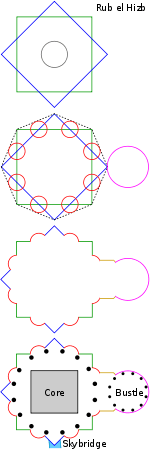
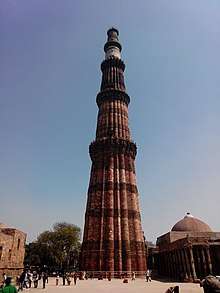
The towers were designed by Argentine architect César Pelli. A distinctive postmodern style was chosen to create a 21st-century icon for Kuala Lumpur, Malaysia. Planning on the Petronas Towers started on 1 January 1992 and included rigorous tests and simulations of wind and structural loads on the design. Seven years of construction followed at the former site of the original Selangor Turf Club, beginning on 1 March 1993 with excavation, which involved moving 500 truckloads of earth every night to dig down 30 metres (98 ft) below the surface.
The construction of the superstructure commenced on 1 April 1994. Interiors with furniture were completed on 1 January 1996, the spires of Tower 1 and Tower 2 were completed on 1 March 1996, 3 years after its construction was started, and the first batch of Petronas personnel moved into the building on 1 January 1997. The building was officially opened by the Prime Minister of Malaysia's Tun Dr. Mahathir bin Mohamad on 31 August 1999.[15] The twin towers were built on the site of Kuala Lumpur's race track.[16] Test boreholes found that the original construction site effectively sat on the edge of a cliff. One half of the site was decayed limestone while the other half was soft rock. The entire site was moved 61 metres (200 ft) to allow the buildings to sit entirely on the soft rock.[17] Because of the depth of the bedrock, the buildings were built on the world's deepest foundations.[18] 104 concrete piles, ranging from 60 to 114 metres (197 to 374 ft) deep, were bored into the ground. The concrete raft foundation, comprising 13,200 cubic metres (470,000 cu ft) of concrete was continuously poured through a period of 54 hours for each tower. The raft is 4.6 metres (15 ft) thick, weighs 32,500 tonnes (35,800 tons) and held the world record for the largest concrete pour until 2007.[17] The foundations were completed within 12 months by Bachy Soletanche and required massive amounts of concrete.[19]
As a result of the Malaysian government specifying that the buildings be completed in six years, two construction consortia were hired to meet the deadline, one for each tower. Tower 1, the west tower (left in the top-right photograph) was built by a Japanese consortium led by the Hazama Corporation (JA Jones Construction Co., MMC Engineering Services Sdn Bhd, Ho Hup Construction Co. Bhd and Mitsubishi Corp) while Tower 2, the east tower (right in the top-right photograph) was built by a South Korean consortium led by the Samsung C&T Corporation (Kukdong Engineering & Construction and Syarikat Jasatera Sdn Bhd).
Early into construction a batch of concrete failed a routine strength test causing construction to come to a complete halt. All the completed floors were tested but it was found that only one had used a bad batch and it was demolished. As a result of the concrete failure, each new batch was tested before being poured. The halt in construction had cost US$700,000 per day and led to three separate concrete plants being set up on the site to ensure that if one produced a bad batch, the other two could continue to supply concrete. The sky bridge contract was completed by Kukdong Engineering & Construction. Tower 2 (Samsung C&T) became the first to reach the world's tallest building at the time.
Due to the huge cost of importing steel, the towers were constructed on a cheaper radical design of super high-strength reinforced concrete.[20] High-strength concrete is a material familiar to Asian contractors and twice as effective as steel in sway reduction; however, it makes the building twice as heavy on its foundation as a comparable steel building. Supported by 23-by-23 metre concrete cores[21] and an outer ring of widely spaced super columns, the towers use a sophisticated structural system that accommodates its slender profile and provides 560,000 square metres of column-free office space.[22] Below the twin towers is Suria KLCC, a shopping mall, and Petronas Philharmonic Hall, the home of the Malaysian Philharmonic Orchestra.
Notable events
On 15 April 1999, Felix Baumgartner set the world record for BASE jumping (since broken) by jumping off a window cleaning crane on the Petronas Towers.[23][24]
- Thousands of people were evacuated on 12 September 2001 after a bomb threat the day after the September 11 attacks destroyed the World Trade Center towers in New York City. Bomb Disposal squads found no bomb in the Petronas towers but they evacuated everyone. Workers and shoppers were allowed to return three hours later, around noon. No one was hurt during the evacuation.[25]
- On the evening of 4 November 2005, a fire broke out in the cinema complex of the Suria KLCC shopping centre below the Petronas Towers, triggering panic among patrons. There were no reports of injuries. The buildings were largely empty, except the shopping mall, Suria KLCC, because of the late hour; the only people involved were moviegoers and some diners in restaurants.[26]
- On the morning of 1 September 2009, French urban climber Alain "Spiderman" Robert, using only his bare hands and feet and with no safety devices, scaled to the top of Tower Two in just under 2 hours after two previous efforts had ended in arrest.[27] In his first attempt on 20 March 1997, police arrested him at the 60th floor, 28 floors away from the "summit". The second attempt on 20 March 2007, exactly 10 years later, was also stopped on the same floor, though on the other tower.[28]
Anchor tenants
Tower One is fully occupied by Petronas and a number of its subsidiaries and associate companies, while the office spaces in Tower Two are mostly available for lease to other companies.[29] A number of companies have offices in Tower Two, including SapuraOMV Upstream (Sarawak) Inc., Huawei Technologies, AVEVA, Al Jazeera English, Carigali Hess, Bloomberg, Boeing, IBM, Khazanah National Berhad, McKinsey & Co, WIPRO Limited, TCS, HCL Technologies, Krawler, Microsoft, The Agency (a modelling company) and Reuters.
Floor plan
| Levels | Tower 1 | Tower 2 |
|---|---|---|
| 88 | Mechanical | |
| 87 | ||
| 86 | Lounge | Observatory Deck |
| 85 | Boardroom | Multimedia Conference Room |
| 84M3 | Mechanical | |
| 84M2 | ||
| 84M1 | ||
| 84 | ||
| 83 | Lounge | Observatory Deck Gift Shop |
| 82 | Office Zone 5 | |
| 81 | ||
| 80 | ||
| 79 | ||
| 78 | ||
| 77 | ||
| 76 | ||
| 75 | ||
| 74 | ||
| 73 | Office Zone 4 | |
| 72 | ||
| 71 | ||
| 70 | ||
| 69 | ||
| 68 | ||
| 67 | ||
| 66 | ||
| 65 | ||
| 64 | ||
| 63 | ||
| 62 | ||
| 61 | ||
| 60 | Office Zone 3 | |
| 59 | ||
| 58 | ||
| 57 | ||
| 56 | ||
| 55 | ||
| 54 | ||
| 53 | ||
| 52 | ||
| 51 | ||
| 50 | ||
| 49 | ||
| 48 | ||
| 47 | ||
| 46 | ||
| 45 | ||
| 44 | ||
| 43 | ||
| 42 | Sky Bridge connected to Tower 2, Sky Lobby | Sky Bridge connected to Tower 1, Sky Lobby, Malaysian Petroleum Club |
| 41 | ||
| 40 | Conference Centre, Executive Dining Room | |
| 39 | Mechanical | |
| 38 | ||
| 37 | Conference Centre | |
| 36 | Office Zone 2 | |
| 35 | ||
| 34 | ||
| 33 | ||
| 32 | ||
| 31 | ||
| 30 | ||
| 29 | ||
| 28 | ||
| 27 | ||
| 26 | ||
| 25 | ||
| 24 | ||
| 23 | Office Zone 1 | |
| 22 | ||
| 21 | ||
| 20 | ||
| 19 | ||
| 18 | ||
| 17 | ||
| 16 | ||
| 15 | ||
| 14 | ||
| 13 | ||
| 12 | ||
| 11 | ||
| 10 | ||
| 9 | ||
| 8 | ||
| 7 | Mechanical | |
| 6 | ||
| 5 | Petronas Petroleum Resource Centre, Petrosains Discovery Centre | Petrosains Discovery Centre |
| 4 | ||
| 3 | Surau Al-Muhsinin | Petronas Art Gallery |
| 2 | Petronas Philharmonic Hall | |
| 1 | Entrance Lobby | |
| Ground Level | ||
| Concourse Mezzanine | Mechanical, Loading Dock | |
| Concourse Level | Observatory Deck Entrance, Gift Shop, Petronas Cards Centre, Mesra Shoppe, Twin Towers Fitness Centre | |
| P1 | Carpark, Mechanical | |
| P2 | ||
| P3 | ||
| P4 | ||
| P5 | ||
Features
Suria KLCC
Suria KLCC is a 140,000 m2 (1,500,000 sq ft) upmarket retail center at the feet of the Petronas Towers. It features mostly foreign luxury goods and high-street labels. Its attractions include an art gallery, an underwater aquarium and also a Science center. Boasting approximately 300 stores, Suria KLCC is touted as one of the largest shopping malls in Malaysia.[30] The Petronas Philharmonic Hall, also built at the base of the towers, is frequently associated with Suria KLCC's floorspace.
 Inside View of Suria KLCC Shopping Centre
Inside View of Suria KLCC Shopping Centre- Inside the Suria KLCC
%2C_Kuala_Lumpur.jpg) Entrance of Suria KLCC
Entrance of Suria KLCC
KLCC Park
Spanning 17 acres (6.9 ha) below the building is the KLCC Park with jogging and walking paths, a fountain with incorporated light show, wading pools, and a children's playground.
Skybridge
The towers feature a double decker skybridge connecting the two towers on the 41st and 42nd floors, which is the highest 2-story bridge in the world.[31] It is not attached to the main structure, but is instead designed to slide in and out of the towers to prevent it from breaking,[32] as the towers sway several feet in towards and away from each other during high winds. It also provides some structural support to the towers in these occasions. The bridge is 170 m (558 ft) above the ground and 58.4 m (192 ft) long, weighing 750 tons.[33] The same floor is also known as the podium, since visitors going to higher levels have to change elevators here. The skybridge is open to all visitors, but tickets are limited to about 1,000 people per day, and must be obtained on a first-come, first-served basis. Initially, the visit was free but in 2010, the tickets started being sold by Petronas. Visitors can choose to opt for package one which is just a visit to the skybridge or go for package two to go to the skybridge and all the way to level 86.[34] Visitors are only allowed on the 41st floor as the 42nd floor can only be used by the tenants of the building.[35]
The skybridge also acts as a safety device, so that in the event of a fire or other emergency in one tower, tenants can evacuate by crossing the skybridge to the other tower.[36] The total evacuation triggered by a bomb hoax on 12 September 2001 (the day after the September 11 attacks destroyed the twin towers of the World Trade Center in New York City) showed that the bridge would not be useful if both towers need to be emptied simultaneously, as the capacity of the staircases was insufficient for such an event.[37] Plans thus call for the lifts to be used if both towers need to be evacuated, and a successful drill following the revised plan was conducted in 2005.
There is a two hinged arch that supports the skybridge with arch legs, each 51 metres (167 ft) long, that are bolted to level 29 of each of the towers.[38] After being constructed on the ground, the skybridge was lifted into place on the towers over a period of three days[39] in July 1995.[38] Instead of being directly connected to the towers, the skybridge can shift or slide in and out of them to counterbalance any effect from the wind. Residing on the 41st and 42nd floors, the skybridge connects a conference room, an executive dining room and a prayer room.[39]
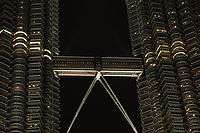 A skybridge connects the two towers
A skybridge connects the two towers- An inside view of the skybridge
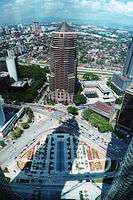 View to the northwest from the Petronas Towers skybridge, including the shadow of Tower 1 and the skybridge, and the Public Bank Berhad building
View to the northwest from the Petronas Towers skybridge, including the shadow of Tower 1 and the skybridge, and the Public Bank Berhad building
Lift system
The main bank of Lifts is located in the centre of each tower. All main lifts are double-decker with the lower deck of the lift taking passengers to even-numbered floors and upper deck to odd-numbered floors. To reach an odd-numbered floor from ground level, passengers must take an escalator to the upper deck of the lift.[40]
There are 29 double-deck passenger elevators, but there are different sets that service certain floors of the towers, specifically two sets of six of these double-deck passenger elevators to floors 1–23 and 1–37 respectively. Another set of 5 passenger lifts transport passengers to the 41st and 42nd floors where they can switch lifts to reach the upper zones of the buildings, each double-deck passenger lift with the capacity of 52 passengers or, 26 passengers per deck. There are also 6 heavy-duty elevators for utility.
The lift operating chart of the Petronas Towers
- PL7A-PL7C (Tower 1) & PL8A-PL8C (Tower 2)(Parking & Podium Passenger Lift): P5-P1, C, G, 1, 2, 2M, 3-5 (PL7A & PL8A non-stop at level 2M)
- SL6 (Tower 1) & SL7 (Tower 2)(Parking & Podium Service Lift): P5-P1, 1, 2, 2M, 3-5 (SL7 non-stop at level 2M)
- PL14 (Tower 1) & PL15 (Tower 2)(Concert Passenger Lift): G, 2, 2M, 3, 4
- A1-A6 (Tower 1) & A7-A12 (Tower 2)(Bank A Passenger Lift): G/1, 8-23
- B1-B6 (Tower 1) & B7-B12 (Tower 2)(Bank B Passenger Lift): G/1, 23-37
- CF1-CF2 (Tower 1) & CF3-CF4 (Tower 2)(Conference Shuttle Lift): 36, 37, 40-43
- C1-C6 (Tower 1) & C7-C12 (Tower 2)(Bank C Passenger Lift): 41/42, 44-61
- D1-D3 (Tower 1) & D4-D6 (Tower 2)(Bank D Passenger Lift): 41/42, 61, 69-83
- E1-E3 (Tower 1) & E4-E6 (Tower 2)(Bank E Passenger Lift): 41/42, 61-73
- TE1-TE2 (Tower 1) & TE3-TE4 (Tower 2)(Upper Level Passenger Lift): 83, 85, 86
- SH1-SH5 (Tower 1) & SH6-SH10 (Tower 2)(Shuttle Lift): G/1, 41/42
- S1-S2 (Tower 1) & S4-S5 (Tower 2) (Service Lift): P1, C, G, 2-6, 8-38, 40-84
- S3 (Tower 1) & S6(Tower 2) (Lower Level Service Lift): P1, C, G, 2-6, 8-37
- F1-F2 (Tower 1) & F3-F4 (Tower 2) (Fireman Service Lift): P1, C, CM, G, 1-6, 8-38, 40-84, 84M1, 84M2, 85, 86 (F1 & F3 non-stop at Level 1)
Service building
The service building is to the east of the Petronas Towers and contains the chiller plant system and the cooling towers to keep the Petronas Towers cool and comfortable.
Ticketing system
In order to visit Petronas towers, visitors must first purchase tickets. Tickets can be purchased online or at the counter. Discounted tickets for seniors are available for those 55 years of age and above. Queues for tickets can get quite long sometimes. The complete ticketing system is provided by the Malaysian-based Longbow Technologies Sdn Bhd.
In popular culture
- The towers are prominently featured and mentioned by name in the 1999 film Entrapment, with numerous scenes filmed at the towers, with the climax set on the skybridge. CGI was used to add slums to the bottom of the towers.[41]
- The Towers appear in the first episode of the US TV series 24.
- Several scenes of the Bollywood film Don: The Chase Begins Again were also filmed in the Petronas Towers and its skybridge.
- In Part 1 of the Phineas and Ferb episode "Phineas and Ferb Save Summer!", the towers are visible during the musical number "Summer All Over the World".
- Eidos Interactive has twice used the towers for inspiration in their video games. In the 2002 Hitman 2: Silent Assassin, the Malaysia-based levels Basement Killing, The Graveyard Shift, and The Jacuzzi Job all take place in the Petronas Towers.[42] In 2010's Just Cause 2, the fictional Panau Falls Casino is based on the Petronas Towers.
- A 2002 episode of the animated series Jackie Chan Adventures titled "When Pigs Fly" (Season 3, Episode 6), features the towers.
- A 2002 episode of The Amazing Race 3 ("Why Did You Have To Take Your Pants Off?") featured the Petronas Towers as part of a task in which the competing team had to have their photograph taken in front of the towers.[43] The towers were seen again 21 seasons later on an episode of The Amazing Race 24 ("Smarter, Not Harder").[44]
- The towers made its appearance, in the animated series Totally Spies episode titled "Man or Machine".
- The opening of the 2010 film Fair Game had scenes with the twin towers along with the skyline of Kuala Lumpur.[45]
- A number of scenes for the 2012 Hong Kong-Chinese action film Viral Factor included shots of the twin towers.[46]
- In the 2016 film Independence Day: Resurgence, the towers are dropped onto the London Tower Bridge by aliens, with a character commenting: "They like to get the landmarks".[47]
- In the 2009 History Channel original program Life After People, the towers make an appearance in the episode titled "Bound and Buried", and it is stated that the towers would survive approximately 500 years without human maintenance, eventually collapsing from the weathering and erosion of Malaysia's tropical climate.
Photo gallery
.jpg) Petronas Towers with its surroundings in December 2019
Petronas Towers with its surroundings in December 2019.jpg) At night from 29th floor of Traders Hotel
At night from 29th floor of Traders Hotel Looking up from the base at night with a large Malaysian flag
Looking up from the base at night with a large Malaysian flag- Petronas Towers in Kuala Lumpur, Malaysia at sunset
 Night image of the Petronas Towers in Kuala Lumpur, taken from behind
Night image of the Petronas Towers in Kuala Lumpur, taken from behind- Petronas Towers, Kuala Lumpur, Malaysia
- One of the Petronas Towers spires
 Inside View of Festival Time at Petronas Twin Tower
Inside View of Festival Time at Petronas Twin Tower The Petronas Towers from their bases
The Petronas Towers from their bases
See also
- The Exchange 106
- List of skyscrapers
- List of tallest buildings and structures in the world
- List of tallest buildings in Kuala Lumpur
- List of tallest buildings in Malaysia
- List of tallest freestanding structures in the world
- Menara Telekom
- Merdeka PNB 118
- Skyscraper Index
- Vanity height
References
- "25 world-famous skyscrapers". cnn.com. CNN Travel. 6 August 2013.
- "Petronas Towers – The Skyscraper Center". Council on Tall Buildings and Urban Habitat. Archived from the original on 24 May 2012.
- Petronas Towers at Emporis
- Petronas Towers at Glass Steel and Stone (archived)
- "Petronas Towers". SkyscraperPage.
- Petronas Towers at Structurae
- http://www.ctbuh.org/LinkClick.aspx?fileticket=rlKQFdZyhwg%3D&tabid=1108&language=en-GB
- Lee, P. K. K. (January 1997). Structures in the New Millennium. ISBN 9789054108986.
- "Archived copy". Archived from the original on 14 July 2014. Retrieved 18 June 2014.CS1 maint: archived copy as title (link)
- "know about". Constructing world. Archived from the original on 24 July 2018.
- "Archived copy". Archived from the original on 24 July 2018. Retrieved 16 February 2018.CS1 maint: archived copy as title (link)
- Wee, C. J. Wan-Ling, April Stonghold, James Parpan Almeda (2002). Local cultures and the "new Asia": the state, culture, and capitalism in Southeast Asia. Institute of Southeast Asian Studies. p. 193.
- Moskal, Greg (2004). Modern Buildings: Identifying Bilateral and Rotational Symmetry. New York: Rosen Classroom. p. 28. ISBN 0-8239-8989-5.
- Galal Abada, "2004 On Site Review Report: Petronas Office Towers, Kuala Lumpur, Malaysia" Archived 2012-10-01 at the Wayback Machine
- Sebestyén, Gyula (1998). Construction: Craft to Industry. London: Taylor & Francis. p. 205. ISBN 978-0-419-20920-1.
- Žaknić, Ivan; Smith, Matthew; Rice, Doleres B. (1998). 100 of the World's Tallest Buildings. Mulgrave, Victoria: Images Publishing. p. 208. ISBN 978-1-875498-32-1.CS1 maint: multiple names: authors list (link)
- National Geographic Channel International / Caroline Anstey (2005), Megastructures: Petronas Twin Towers
- Baker, Clyde N., Jr.; Drumwright, Elliott; Joseph, Leonard; Azam, Tarique (November 1996). "The Taller the Deeper". Civil Engineering. ASCE. 66 (11): 3A–6A.CS1 maint: multiple names: authors list (link)
- Admin. (18 March 2010). "Detailed Structural Analysis". The Petronas Towers. Archived from the original on 1 November 2010. Retrieved 11 January 2011.
- Wells, Matthew (2005). Skyscrapers: structure and design. Laurence King Publishing. p. 170.
- "Information Malaysia." (2005). Berita Publ. Sdn. Bhd.
- Taranath, Bungale S. (2004). Wind and earthquake resistant buildings: structural analysis and design. CRC Press. p. 748.
- Crerar, Simon (15 October 2012). "Planes, caves and skyscrapers among fearless skydiver Felix Baumgartner's fabulous feats". Herald Sun. Retrieved 21 October 2012.
- "Petronas Towers (451 Meters), Malaysia". felixbaumgartner.com. Felix Baumgartner. Archived from the original on 22 September 2010. Retrieved 21 October 2012.
- Sean Yoong (12 September 2001). "World's tallest towers, IBM building in Malaysia evacuated after threats". The Avalanche Journal. Archived from the original on 19 July 2012. Retrieved 11 January 2011.
- "Fire Forces Evacuation at Malaysia Towers". CBS News. 4 November 2005. Retrieved 11 January 2011.
- staff writers (1 September 2009). "'Spiderman' scales Malaysia tower". BBC News. Retrieved 11 January 2011.
- St (20 March 2007). "'Spiderman' has another go at Twin Tower". The Star. Archived from the original on 22 June 2011. Retrieved 11 January 2011.
- Sheela Chandran (25 August 2005). "Documentary on the Petronas Twin Towers". The Star (Malaysia). Retrieved 2 December 2010.
- de Ledesma, Charles; Lewis, Mark; Savage, Pauline (2003). Rough guide to Malaysia, Singapore & Brunei. New York; London; Delphi: Rough Guides. p. 132. ISBN 1-84353-094-5.CS1 maint: multiple names: authors list (link)
- Frankham, Steve (2008). Malaysia and Singapore. Bath: Footprint Travel Guides. p. 68. ISBN 978-1-906098-11-7.
- Moskal, Greg (2004). Modern Buildings: Identifying Bilateral and Rotational Symmetry.i Rosen Classroom. p. 26.
- Chang, Fu-Kuo (2005). Structural health monitoring, 2005: advancements and challenges for implementation. Lancaster, PA: DEStech Publications. p. 270. ISBN 1-932078-51-7.
- "The Petronas Towers Skybridge". The Petronas Towers. 25 October 2010. Archived from the original on 7 November 2009. Retrieved 2 December 2010.
- Rowthorn, Chris; Cohen, Muhammad; Williams, China (2008). Lonely Planet Borneo. Lonely Planet. p. 71.
- Wood, A.; Chow, W. K.; McGrail, D. (2005). "The Skybridge as an Evacuation Option for Tall Buildings for Highrise Cities in the Far East". Journal of Applied Fire Science. 13 (2): 113–124. doi:10.2190/1417-hh0k-1w74-170r.
- World's Tallest Towers in Malaysia Evacuated After Threats. People's Daily. 12 September 2001.
- "The PETRONAS Twin Towers Official Website". PETRONAS Twin Towers. Retrieved 29 March 2012.
- Wheeler, Mark (May 1996). "The World's Tallest Building". Popular Mechanics. Retrieved 29 March 2012.
- "Petronas Towers Lift System". The Petronas Towers. 25 October 2010. Archived from the original on 7 November 2009. Retrieved 2 December 2010.
- "BBC News - Entertainment - Entrapment rapped by Malaysian PM". news.bbc.co.uk.
- "Hitman 2 Silent Assassin Prima Official eGuide". Scribd.com. 26 December 2012. Retrieved 14 June 2013.
- Balderas, Christopher (30 August 2018). "20 Of The Sickest Places Featured On The Amazing Race (That We Can Visit Too)". TheTravel. Retrieved 8 January 2020.
- Kwiatkowski, Elizabeth (17 March 2014). "'The Amazing Race: All-Stars' "Newlyweds" team Brendon Villegas and Rachel Reilly survive non-elimination leg". Reality TV World. Retrieved 8 January 2020.
- https://musamonga.com/2017/05/03/5-hollywood-films-in-malaysia/ Hollywood movies shot in Malaysia
- http://www.hkmdb.com/db/movies/view.mhtml?id=14703&display_set=eng Viral Factor
- https://www.nst.com.my/news/2016/04/141082/petronas-twin-towers-features-independence-day-sequel-its-not-good-news Independence Day: Resurgence
External links
| Wikimedia Commons has media related to Petronas Towers. |
- Petronas Towers official website
- Petronas Tower 1 on CTBUH Skyscraper Center
- Petronas Tower 2 on CTBUH Skyscraper Center
- Petronas Towers at Structurae
- Introduction and Overview of the Petronas Towers

| Records | ||
|---|---|---|
| Preceded by Willis Tower |
World's tallest building architectural element 452.0 m (1,482.9 ft) 1998–2003 |
Succeeded by Taipei 101 |
| Preceded by World Trade Center |
World's tallest twin towers 452.0 m (1,482.9 ft) 1998–present |
Succeeded by incumbent |
